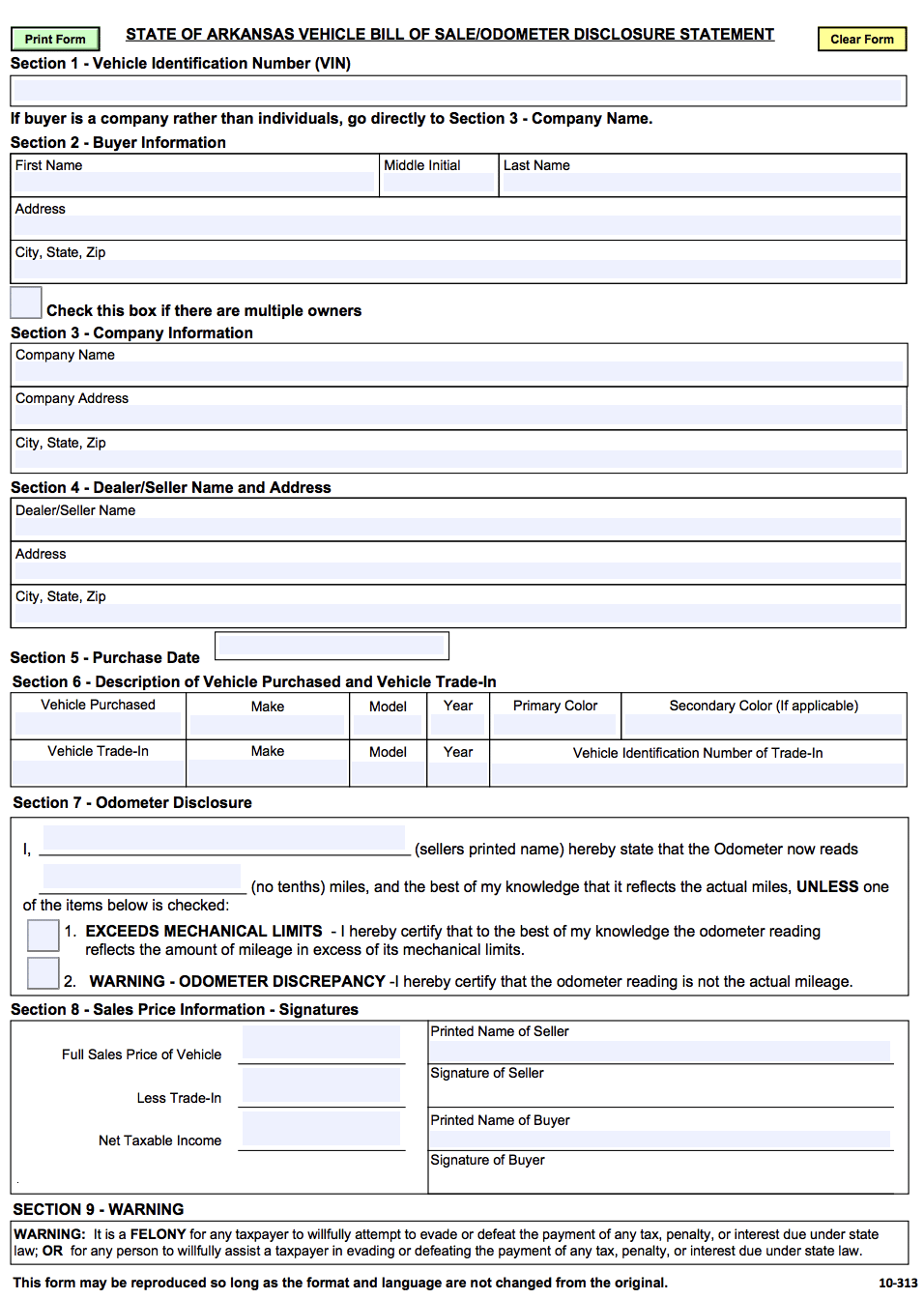The Arkansas DMV bill of sale form is essentially a record of a transaction of one’s personal property to another. In this case, the personal property is specific to a vehicle such as a car, truck, motorcycle, etc. A bill of sale is only legally required if the seller would like to apply for a “sales tax credit” or if there is no room on the title for the seller to sign the vehicle over. Even if neither of these applies to your situation, it is still a good idea to have a bill of sale for your records. The vehicle information must be recorded on to the document along with both the buyer and seller’s information, as well as both parties’ signatures.
How to Register a Vehicle
Once you have purchased your new vehicle, you have up to 30 days to have it registered. Visit your local OMV(Office of Motor Vehicle) and be sure to bring the following items:
- The title of the vehicle.
- Bill of sale (if there was no room for the seller to sign on the title).
- A Vehicle Registration Application (Form 10-381) that must be completed upon arrival (this application is also used for titling).
- You must provide an Odometer Disclosure Statement (If your vehicle is less than 10 years old, it can be found on the back of the title).
- Proof of VIN verification – corresponding with § 27-14-725.
- Proof the vehicle has been assessed by a certified county assessor within the present year.
- Proof that all taxes have been paid to date for the vehicle. Evidence such as a county tax collector receipt or a stamp that certifies your tax payment on your assessment papers shall qualify as a sufficient confirmation.
- Proof of insurance.
- Be sure to bring sufficient funds to pay for the registration fees (prices vary by the weight of the vehicle).
How to Write
Download in Adobe PDF.
Step 1 – In the first section, enter the VIN(Vehicle Identification Number) in the area provided. Skip to Step 3 if the buyer is purchasing this under a company name rather than as an individual.
Step 2 – Buyer Information – Input the required information listed below:
- First Name
- Middle Initial
- Last Name
- Address
- City, State, Zip
There is a box displayed below this section that instructs you to check if there are multiple owners.
Step 3 – Company Information – This section allows you to list your company as the buyer. If this applies to you, enter the following:
- Company Name
- Company Address
- City, State, Zip
Step 4 – Dealer/Seller Name and Address – Whether the vehicle is being purchased from a car dealership or an individual, enter the requested info below:
- Dealer/Seller Name
- Address
- City, State, Zip
Step 5 – Purchase Date – Enter the date of sale in the available space.
Step 6 – Description of Vehicle Purchased and Vehicle Trade-In – You are asked to give details of 2 vehicles, the vehicle being purchased as well as the vehicle being traded in. If there is no vehicle being traded in, leave the space blank or insert n/a(no answer). Information needed includes:
- Vehicle Purchased
- Make
- Model
- Year
- Primary Color
- Secondary Color (if applicable)
If you are trading your vehicle to a dealership:
- Vehicle Trade-In
- Make
- Model
- Year
- Vehicle Identification Number of Trade-In
Step 7 – Odometer Disclosure – In this section, the seller must note the mileage read on the odometer. Fill in the following:
- Seller’s Printed Name
- Odometer Reading (no tenths, round up)
Below are 2 boxes. Check if either applies:
- Exceeds Mechanical Limits (by checking this box, you certify that to the best of your knowledge the odometer reading reflects the amount of mileage in excess of its mechanical limits).
- Warning – Odometer Discrepancy (by checking this box, you hereby certify that the odometer reading is not the actual mileage).
Step 8 – Sales Price Information/Signatures – The most crucial section of the form, here is where you will record the following:
- Full Sales Price of Vehicle
- Less Trade-In (if applicable)
- Net Taxable Income
- Printed Name of Seller
- Signature of Seller
- Printed Name of Buyer
- Signature of Buyer
Step 9 – Warning – The final section provides a warning that must be read by both parties that essentially states that it is a felony for any taxpayer to willfully attempt to evade or defeat the payment of any tax, penalty, or interest due under state law; or for any person to willfully assist a taxpayer in evading or defeating the payment of any tax, penalty, or interest due under state law.



0 comments
Comments are closed.